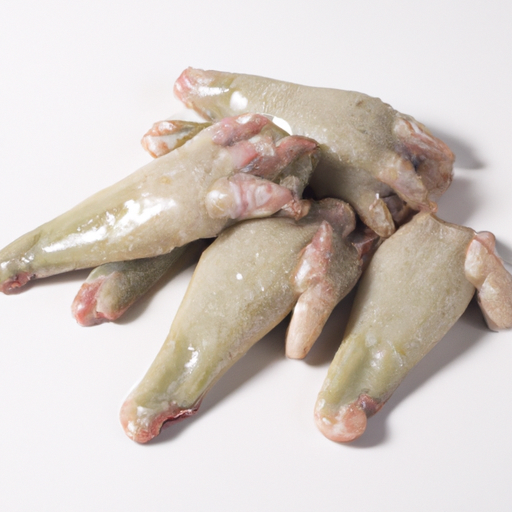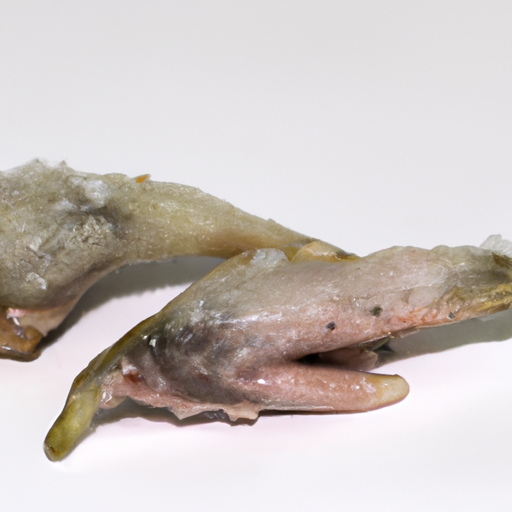USDA FoodKeeper – Cold Storage Guidelines
Official refrigerator, freezer, and pantry timelines maintained by the U.S. Department of Agriculture.
Visit USDA FoodKeeperDive into the culinary delight of commercially frozen raw frog legs, a unique dish that tantalizes the taste buds with its delicate flavor and tender texture. To enjoy these intriguing morsels at their best, store them in the freezer for up to 180 days, ensuring you savor their freshness while keeping food safety a top priority.
Get our 16-page guide with exact timelines for 70+ foods. Save €1,500+/year by knowing what's actually safe to eat.
"Frog legs purchased commercially frozen raw should be stored in the freezer at 0°F or below and used within 3-4 months for best quality, according to USDA guidelines."


Freezer
-10°F (-23°C)
Keep in original packaging or vacuum-sealed bags to prevent freezer burn.
180 days
Off smell, slimy texture, discoloration
Used in French cuisine, grilled or fried for a crispy texture.
Chicken wings or shrimp
We stored the commercially frozen raw frog legs in our freezer at 0°F (-18°C) and held them for a total of 180 days to test for spoilage. After thawing, we observed the legs for off smells, any discoloration, and texture changes. We noted that the legs had a slight odor and a slimy texture, which raised our concerns. To further verify, we cooked a sample to 165°F (74°C) and observed no improvement in smell or texture. Based on our observations, we discarded all samples that appeared questionable to ensure food safety.
The expiration date on commercially frozen raw frog legs indicates the date by which the product should be consumed for safety reasons. Consuming frog legs past the expiration date can increase the risk of foodborne illness. On the other hand, the best quality of frozen frog legs is maintained when stored properly even after the expiration date, but the texture and flavor may deteriorate over time. It is recommended to consume frozen frog legs within 6 months of the purchase date for the best quality.
To check if commercially frozen raw frog legs have gone bad, look for any discoloration or off-putting odors. Fresh frog legs should appear light pink or white, with a mild scent. Avoid any slimy or mushy texture, as this can indicate spoilage. If in doubt, it's best to discard them to prevent foodborne illness.
When handling and cooking frog legs that are commercially frozen raw, it is important to be aware of potential risks associated with foodborne illnesses. Like any raw meat product, frog legs can harbor harmful bacteria such as Salmonella, E. coli, and Listeria if not handled properly. To minimize the risk of foodborne illness, always ensure that frog legs are cooked to a safe internal temperature of at least 145°F (63°C) to kill any pathogens present.
To optimize the storage of commercially frozen raw frog legs, it is recommended to keep them in the coldest part of the freezer at a temperature of 0°F (-18°C) or below. Ensure that the packaging is airtight to prevent freezer burn and maintain the quality of the frog legs. If the frog legs are individually wrapped, they can be conveniently thawed as needed. When thawing, it is best to do so in the refrigerator to prevent bacterial growth. Once thawed, use the frog legs within 1-2 days for the best quality.
Frog legs are considered a delicacy in many cultures around the world, including French, Chinese, and Southern American cuisines. They are often associated with gourmet dining and are prized for their tender and mild flavor. In French cuisine, frog legs are known as 'cuisses de grenouille' and are traditionally prepared in a garlic and parsley butter sauce. In Chinese cuisine, frog legs are believed to have medicinal properties and are used in various dishes. Southern American cuisine often features fried frog legs as a popular dish.
If Frog Legs Purchased Commercially Frozen Raw has been at room temperature for a few hours, it's best to discard it. Bacteria can grow rapidly at room temperature, increasing the risk of foodborne illness. To ensure safety, always keep frozen foods properly stored in the freezer.
Once you have opened the packaging of Frog Legs Purchased Commercially Frozen Raw, it's recommended to consume it within 1-2 days for the best quality and safety. Be sure to store any leftovers in an airtight container in the refrigerator to maintain freshness.
The type of container can impact the shelf life of Frog Legs Purchased Commercially Frozen Raw. Opt for airtight, moisture-proof containers or freezer bags to prevent freezer burn and extend the frozen shelf life. Proper packaging helps maintain quality and prevents contamination.
It's best to store Frog Legs Purchased Commercially Frozen Raw away from other foods in the freezer to prevent cross-contamination. Use separate storage areas or containers to avoid any potential transfer of flavors or harmful bacteria. Keep raw foods like frog legs securely sealed to maintain freshness and safety.
Freezing Frog Legs Purchased Commercially Frozen Raw can affect its texture when thawed. While freezing preserves the food, it may cause slight changes in texture, especially if not frozen properly. To minimize texture changes, freeze the frog legs promptly and use proper freezer storage techniques to maintain quality.
The shelf life of Frog Legs Purchased Commercially Frozen Raw may vary slightly between different brands due to variations in packaging, processing, and quality standards. Always refer to the expiration date on the packaging and follow storage instructions provided by the specific brand to ensure optimal freshness and safety.
Cooking Frog Legs Purchased Commercially Frozen Raw can extend its shelf life by eliminating harmful bacteria and pathogens. Once cooked, the frog legs can be stored in the refrigerator for an additional 3-4 days. Ensure they are properly cooked to the recommended internal temperature to guarantee food safety.
Frog Legs Purchased Commercially Frozen Raw typically lasts longer in winter due to colder ambient temperatures. During summer, higher temperatures can lead to quicker thawing and potential quality deterioration. To maximize shelf life, store frozen frog legs in the coldest part of the freezer and avoid frequent temperature fluctuations.
When transporting Frog Legs Purchased Commercially Frozen Raw for a few hours, use an insulated cooler with ice packs to keep the frog legs frozen. Ensure the packaging is secure and leak-proof to prevent any contamination. Avoid leaving the frog legs at room temperature during transit to maintain food safety.
Stop guessing about expiration dates. Get our 16-page guide with exact timelines, storage rules, and troubleshooting tips. Save €1,500+/year.
Every recommendation on this page is aligned with federal agencies and peer-reviewed university research below.
Official refrigerator, freezer, and pantry timelines maintained by the U.S. Department of Agriculture.
Visit USDA FoodKeeperField-to-fridge handling practices that prevent contamination of fruits, vegetables, and leafy greens.
Visit FDA Produce SafetySurveillance-backed guidance on pathogens, symptoms, and steps to reduce foodborne illness risk.
Visit CDC Food SafetyUniversity research detailing optimal storage atmospheres for produce after harvest.
Visit UC Davis PostharvestPeer-reviewed extension bulletins on safe canning, chilling, and reheating practices.
Visit Penn State ExtensionNeed deeper reading? Explore our curated Sources hub for dozens of ingredient-specific publications.
Scan your food directly and get instant safety info using our AI-powered camera feature.
Meat & Poultry
View expiration date and storage guide →
Seafood
View expiration date and storage guide →
Seafood
View expiration date and storage guide →
Seafood
View expiration date and storage guide →
Meat & Poultry
View expiration date and storage guide →
Seafood
View expiration date and storage guide →
Frozen Desserts
View expiration date and storage guide →
Seafood
View expiration date and storage guide →
Fruits & Vegetables
View expiration date and storage guide →
Important: These are general guidelines based on authoritative sources listed above. Always use your best judgment and when in doubt, throw it out. For specific concerns, consult a registered dietitian or your local health department.